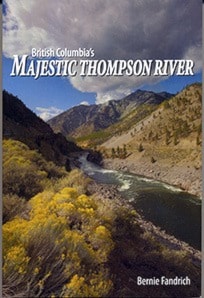It’s all too easy to take our region for granted. Sweeping vistas, beautiful views, and natural wonders that thrill visitors barely register with residents, who are more intent on getting from point A to point B. Sometimes, while driving in our area, I’ll try to view my surroundings as a tourist would see them; and I never fail to be impressed by the beauty around me.
Bernie Fandrich’s British Columbia’s Majestic Thompson River captures this beauty; not only in the pictures, many of them in colour, but in the loving descriptions of the Thompson and its surroundings from Savona to Lytton. As befits the founder of Kumsheen Raft Adventures, Fandrich – whose intimate knowledge of the Thompson in all its moods extends over four decades – devotes the early part of the book to an examination of the river from the perspective of one who is travelling it. The 117 km journey is covered in four chapters (Savona to Ashcroft; Ashcroft to Spences Bridge; Spences Bridge to Nicomen; and Nicomen to Lytton), with each chapter detailing what a traveller on the Thompson will see as she makes her way down the river. Whether it be the site of a land- or rockslide, an interesting geologic feature, a town, the remains of a long-abandoned village, or one of the river’s many rapids, rocks, and put-ins, Fandrich identifies and describes it, often reaching far back into the past to do so.
I recently drove down to a spot on the river I had long been meaning to visit. The only identifying sign was a railway marker bearing the single word “Martel”. When I got home I consulted Fandrich’s book, and learned that I had stopped at the Martel Put-in, 46.9 km north of Lytton. Martel was Joe Martel (1864-1933), originally from Quebec, who took over a ranch 1.5 km south of the put-in’s location in the 1880s or 1890s and established an orchard there. He was a friend of anthropologist James Teit, and obviously had a good sense of humour; when a friend said to him, after an accident on the river, “Joe, you could have been killed!” Martel replied “Oh, that’s all right. Lots more Frenchmen in Quebec.”
It is this level of research and detail that makes Majestic Thompson River more than “just” a book for river rafters. There are chapters covering the first descent of the Thompson by European explorers (in 1828); the towns along the river, and the historic events that took place on and near it, as well as those which occurred on the roads, trails, and rails in the Thompson’s vicinity; the construction and early days of the Canadian Pacific Railway, and a look at the Chinese workers who played such a large part in the CPR’s construction; the plants to be found along the river (you will never confuse sagebrush and rabbit bush again); some of the characters who gave colour to the area over the decades; and a miscellany of facts, history, legend, and geology. For example, David Thompson never saw the river which was named after him; he was busy mapping the headwaters of the Columbia River in 1808, not those of the river which now bears his name, as Simon Fraser (who did the naming) thought.
And did you know that in 1881 a paddlewheeler called the Peerless made it all the way down the Thompson from Savona to Ashcroft and back again? Measuring 131 feet long and 25 feet wide, she would have been an impressive sight on the river, and the relative ease of the journey encouraged thoughts of a regular supply run from Kamloops all the way down to Spences Bridge, supplying the railway camps along the river and transporting goods in both directions. The plan was scuppered when it was found that while passage downriver to Spences Bridge was not difficult, the return trip – against the flow of the river – was perilous at best, with the Peerless nearly coming to grief in the treacherous Black Canyon section of the river south of Ashcroft. Only the captain’s skill kept the boat from smashing to pieces, and a supply run down the river to Spences Bridge was permanently shelved.
All this and much more is covered in loving detail in British Columbia’s Majestic Thompson River. Map coordinates and distance from Lytton (in kilometres) for almost every site mentioned make it easy to identify locations; this is the perfect book to have in the car as you travel to or from the Coast. Armchair travellers can enjoy the many photographs and revel in Fandrich’s vivid descriptions, and perhaps plan their next picnic or day trip.
The author’s delight in, and admiration for, the Thompson River and its environs shines through on every page, making the book a joy to read, as well as an invaluable guide. It’s a book that can be dipped into again and again, with something new to savour and enjoy each time. In that, it is much like the river it chronicles so well.
Copies of British Columbia’s Majestic Thompson River are available at the Journal office and many other local retailers, as well as at Chapters.
Barbara Roden
